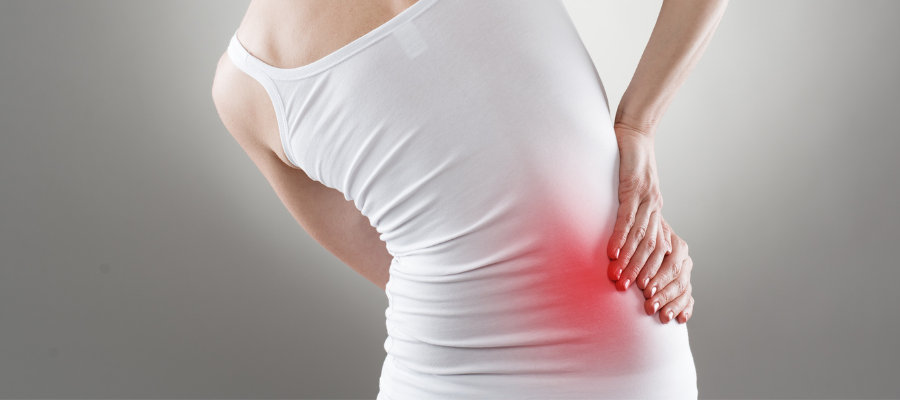|
Healthy hips are so important if you want to stay pain free and active! Hip pain, immobility and sciatica are some of the most common challenges people face. And even though resting may feel like the best way to relieve hip pain, in some cases you may actually need to move a little more instead. A lot of us end up sitting on our hips all day causing some of our muscles to be underused, overstretched, or shortened. This causes imbalances in us which can make even the easiest movements feel painful and more difficult than they have to be. So how do we fix these imbalances? You can start by following this 3 step process to help you work out knots, increase mobility and ultimately strengthen your hips. Surprisingly, strengthening your hips doesn’t only help with hip pain, but can even help alleviate knee and lower back pain as well! Everything is so connected that if those imbalances get out of control they can start causing pain in other areas of the body as well. Before trying anything, however, be sure you check with your doctor if you have any questions or concerns. These 3 steps are meant to be applied to a healthy person. Be sure your hip problems are not related to an underlying medical cause, condition or injury that could be worsened by performing these stretches and exercises. step 1: getting to the root of the problemI’ve talked about foam rolling a lot- and that’s because it serves such an important purpose! In order to get the most out of the next two steps, you must first loosen up any knots and release tension in the muscle. You can, of course, use a foam roller for this, but I sometimes prefer to simply use a tennis ball! The tennis ball allows you to really pinpoint where your knots are and dig in deeper. You can always use a bigger ball or a foam roller if the tennis ball is too painful, however. Remember, the smaller the ball, the deeper it’s going to be able to get. In the video below, you’ll see me demonstrate how to use a tennis ball to attack knots in 3 essential areas around your hips- the piriformis, the quadriceps (your hip flexors), and the gluteus medius. It can be a little painful, but the good news is you don’t actually need to foam roll for very long in order to see results. Studies show that it’s more about consistency (doing it daily) than it is about the length of time. Anything over 30 seconds does not prove to be overly effective. step 2: stretch and mobilizeEveryone always tells me they need to stretch more when their hips hurt. And it’s true, stretching is so important! But combining stretches with movement is even more effective when it comes to alleviating hip pain. Especially if you sit for long periods of time, our muscles get used to not being worked, and sitting still in one position can cause those imbalances we were talking about. It’s important to maintain a good range of motion in your hips and these are the kinds of stretches that are going to help you do this. Reference the video to find out how to do the tick-tock stretch and a static lunge! Step 3: activate the musclesThe last step is to start activating and strengthening those muscles. This is so important for those muscles that don’t get worked enough. And it’s important to do a variety of exercises for muscles around the hip to ensure you will keep everything as balanced as possible. In the video, I show you how to do two exercises that will activate the gluteus maximus and the gluteus medius using a stability ball. A stability ball isn’t necessary, but it’s my favorite way to improve the range of motion on these exercises. The whole point is to start getting these muscles used to working. All in all, if you have balanced, strong hips it will help alleviate sciatica, knee, and lower back pain as well as keeping you active and healthy for years to come. Imbalances happen to all of us, but there are plenty of ways to fix them and this only takes about 3 minutes every day. It doesn’t usually take long to start noticing a difference either. If you start implementing these three steps today, you could notice an improvement within the week. Remember to check out the video below to watch those demonstrations! And you can always find me in my free Facebook group, Weight Loss After 50, where you can ask me questions, get more great health and fitness tips and join a great community of women who are committed to getting and staying healthy!
4 Comments
I thought you made a good point when you mentioned that it is a good idea to seek the advice of a doctor when dealing with a torn meniscus. With that in mind, I would think that it would be a good idea to seek out a sports medicine specialist. I would think that a sports medicine doctor would specialize in this kind of injury. https://chromhearts.com/t-shirts/
Reply
Leave a Reply. |
authorLisa Swanson is an ACE Certified Health Coach, Personal Trainer and Orthopedic Exercise Specialist as well as a certified AASDN and PN level 1 nutritionist. With over 35 years experience helping people turn their lives around, she is on a mission to provide relevant and useful knowledge to help women in midlife reach their goals. featured onCheck out my interview with the Magnificent Midlife podcast on staying fit and healthy long-term.
Categories
All
|
What I DoAt Body & Soul Coaching I empower women over 50 to lose weight and feel confident without deprivation diets or spending hours in the gym.
|
Company |
|
|
© COPYRIGHT 2022. ALL RIGHTS RESERVED.
|
Website Design by My Personal Trainer Website
|



 RSS Feed
RSS Feed